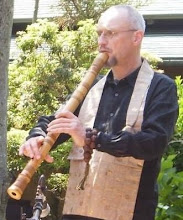|
2021, May: Oliver Aumann, Japanologist and Itchō-ken Player
on 'Komusō', "Meditation", and 'Suizen'
Oliver Aumann, a born German Japanologist and Itchōken Myōan Shakuhachi player, has been living in Japan for decades,
researching, translating, and teaching at honorable, professional Japanese university level.

Oliver Aumann formerly posted most importantly on a now removed website of his - but fortunately,
I secured a fine selection of his important statements for the future.
Now, Oliver Aumann is presenting himself at this weblog of his:
Oliver Aumann: "Komusō Shakuhachi"
2021, May: 'Zen' & "Shakuhachi Meditation" acc. to Oliver Aumann, Japanologist & Itchōken-style Myōan Shakuhachi player:
"Suizen-meditation
How the Shakuhachi is actually used for meditation is a topic often overlooked and seldom referred to explicitly.
There are no traditional texts in the Fuke-sect that would systematically explain how to meditate.
The word nowadays used for this kind of meditation is suizen
吹禅, "Blowing Zen".
The term seems to be relatively modern, but
has become a kind of motto for the modern Komusō.
In many cases suizen refers to nothing more than a ceremonial playing within a temple, with certain strict formalities."
Now outdated URL: https://sites.google.com/site/aumannshakuhachi/meditation-in-english
2021, May: 'Zen' & "Shakuhachi Meditation" acc. to Oliver Aumann:
Zen-Shakuhachi?
"Occasionally the Komusō-Shakuhachi is also known as "Zen Shakuhachi", especially outside of Japan.
It seems that a special relationship with Zen Buddhism, which has become so popular in the West, is to be emphasised.
Unfortunately, in the choice of this term, not only ignorance of the facts, but often also commercial interests play a role ("Zen sells").
For the historical Komusō, a substantive relationship with the Zen school is scarcely verifiable,
and for the modern Komusō, the term "Zen-Buddhist" is simply inaccurate."
Moreover, wrote Oliver Aumann back then, at least in May, 2021:
"
Historically, the only loosely organised group of Shakuhachi-playing begging monks was formally attributed to the Rinzai school of Zen in 1677. *)
The "Legend of the Kyotaku" played an important role in this formal "conversion" of the Komusō movement into Zen."
"The religious theory and practice of the Komusō was, however, by no means purely Zen Buddhist in the narrower sense,
but is influenced by many other aspects of Japanese religiosity.
For the modern Komusō-Shakuhachi players it is true that they were in many cases not formally Zen-Buddhists at the time of their foundation or even today.
Many of their most prominent representatives belonged to other Buddhist denominations.
Higuchi Taizan
樋口対山 (1856-1914) and Uramoto Setchō
浦本浙潮 (1891-1965) were two significant Shakuhachi players
and had a great influence on the reestablishment of the Komusō movement.
But Taizan had originally been a follower of the Jōdo Shin School of Pure Land Buddhism, and converted later to the Lotus Buddhism of the Nichiren School,
and Setchō was an enthusiastic follower of the Jōdo-shin school, that is an Amida-Buddhist."
Now outdated URL: https://sites.google.com/site/aumannshakuhachi/-zen-shakuhachi
*) Comment, T.O.: There is nothing in that so called "Enpō Year 5 Memorandum"
- dated January 11, 1678! - that connects the 'Komusō' to the Rinzai Sect, whatsoever.
Neither is there any reference to any "Fuke Sect" in that document!
Read more here, internal website links:
1678: The Enpō 5, 12th Month Komusō-ha Oboe
Bakufu Memorandum of January 11th, 1678
1950s ... : The Origin of 'Suizen' at Kyōto Myōan-ji:
Kobayashi Shizan, Tomimori Kyozan,
Tanikita Muchiku, Yasuda Tenzan,
Hirazumi Taizan, Koizumi Ryōan,
Fukumoto Kyoan, Yoshimura Sōshin a.o.
|
|

